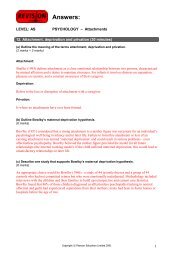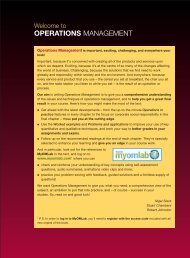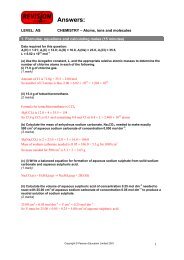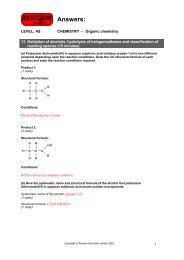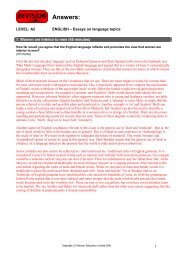Operations and corporate social responsibility (CSR) - Pearson
Operations and corporate social responsibility (CSR) - Pearson
Operations and corporate social responsibility (CSR) - Pearson
- No tags were found...
You also want an ePaper? Increase the reach of your titles
YUMPU automatically turns print PDFs into web optimized ePapers that Google loves.
634Part FiveCorporate <strong>social</strong> <strong>responsibility</strong>Table 21.1 The five dimensions <strong>and</strong> example phrasesThe ‘dimensions’of <strong>CSR</strong>The environmentaldimensionThe <strong>social</strong>dimensionThe economicdimensionThe stakeholderdimensionThe voluntarinessdimensionWhat the definition refers toThe natural environment <strong>and</strong>‘sustainability’ of businesspracticeThe relationship betweenbusiness <strong>and</strong> society in generalSocio-economic or financialaspects, including describing<strong>CSR</strong> in terms of its impact onthe business operationConsidering all stakeholders orstakeholder groupsActions not prescribed by law.Doing more that you have to.Typical phrases used in thedefinition‘a cleaner environment’‘environmental stewardship’‘environmental concerns in businessoperations’‘contribute to a better society’‘integrate <strong>social</strong> concerns in theirbusiness operations’‘consider the full scope of theirimpact on communities’‘preserving the profitability’‘contribute to economicdevelopment’‘interaction with their stakeholders’‘how organizations interact with theiremployees, suppliers, customers<strong>and</strong> communities’‘treating the stakeholders of the firm’‘based on ethical values’‘beyond legal obligations’‘voluntary’<strong>responsibility</strong> is about how we manage our <strong>social</strong> <strong>and</strong> environmental impacts as part of ourday to day business, in order to earn that trust.’ 4‘<strong>CSR</strong> is about how companies manage the business processes to produce an overall positiveimpact on society.’ 5‘Corporate <strong>social</strong> <strong>responsibility</strong> is the commitment of businesses to contribute to sustainableeconomic development by working with employees, their families, the local community <strong>and</strong>society at large to improve their lives in ways that are good for business <strong>and</strong> for development.’ 6‘<strong>CSR</strong> is a concept whereby companies integrate <strong>social</strong> <strong>and</strong> environmental concerns in theirbusiness operations <strong>and</strong> in their interaction with their stakeholders on a voluntary basis.’ 7Although there are so many definitions, according to Alex<strong>and</strong>er Dahlsrud of the NorwegianUniversity of Science <strong>and</strong> Technology 8 almost all of them involve five ‘dimensions’ of <strong>CSR</strong>,as shown in Table 21.1. We will use these dimensions, first to explore <strong>CSR</strong> in general <strong>and</strong>,second, to explore the role of operations management specifically in <strong>CSR</strong>.The whole topic of <strong>CSR</strong> is also rising up the <strong>corporate</strong> agenda. Figure 21.2 shows how onesurvey of executives saw the progressive prioritization of <strong>CSR</strong> issues.The environmental (sustainability) dimension of <strong>CSR</strong>Environmental sustainability (according to the World Bank) means ‘ensuring that the overallproductivity of accumulated human <strong>and</strong> physical capital resulting from developmentactions more than compensates for the direct or indirect loss or degradation of the environment’,or (according to the Brundtl<strong>and</strong> Report from the United Nations) it is ‘meeting theneeds of the present without compromising the ability of future generations to meet theirown needs’. Put more directly, it is generally taken to mean the extent to which businessactivity negatively impacts on the natural environment. It is clearly an important issue, notonly because of the obvious impact on the immediate environment of hazardous waste,air <strong>and</strong> even noise pollution, but also because of the less obvious, but potentially far moredamaging issues around global warming.
Chapter 21 <strong>Operations</strong> <strong>and</strong> <strong>corporate</strong> <strong>social</strong> <strong>responsibility</strong> (<strong>CSR</strong>) 635Figure 21.2 How executives view the importance (degree of priority) of <strong>corporate</strong> <strong>responsibility</strong>Data from the Economist Intelligence Unit, Global Business Barometer, Nov–Dec 2007From the perspective of individual organizations, the challenging issues of dealing withsustainability are connected with the scale of the problem <strong>and</strong> the general perception of ‘green’issues. First, the scale issue is that cause <strong>and</strong> effect in the environmental sustainability areaare judged at different levels. The effects of, <strong>and</strong> arguments for, environmentally sustainableactivities are felt at a global level, while those activities themselves are essentially local. It hasbeen argued that it is difficult to use the concept at a <strong>corporate</strong> or even at the regional level.Second, there is a paradox with sustainability-based decisions. It is that the more the publicbecomes sensitized to the benefits of firms acting in an environmentally sensitive way, themore those firms are tempted to exaggerate their environmental credentials, the so-called‘greenwashing’ effect.One way of demonstrating that operations, in a fundamental way, is at the heart ofenvironmental management is to consider the total environmental burden (EB) created bythe totality of operations activities: 9EB = P × A × TwhereP = the size of the populationA = the affluence of the population (a proxy measure for consumption)T = technology (in its broadest sense, the way products <strong>and</strong> services are made <strong>and</strong>delivered, in other words operations management)Achieving sustainability means reducing, or at least stabilizing, the environmental burden.Considering the above formula, this can only be done by decreasing the human population,lowering the level of affluence <strong>and</strong> therefore consumption, or changing the technology usedto create products <strong>and</strong> services. Decreasing population is not feasible. Decreasing the level ofaffluence would not only be somewhat unpopular, but would also make the problem worsebecause low levels of affluence are correlated with high levels of birth rate. The only optionleft is to change the way goods <strong>and</strong> services are created.Short caseEcological footprints 10To supply the average person’s basic needs in the UnitedStates, it takes 12.2 acres of l<strong>and</strong>. In the Netherl<strong>and</strong>s ittakes 8 acres, <strong>and</strong> in India it takes 1 acre. Calculated thisway, the Dutch ecological footprint covers 15 times thearea of the Netherl<strong>and</strong>s. India’s ecological footprint is1.35 of its area. Most dramatically, if the entire worldlived like North Americans, it would take three planetearths to support the present world population.
Chapter 21 <strong>Operations</strong> <strong>and</strong> <strong>corporate</strong> <strong>social</strong> <strong>responsibility</strong> (<strong>CSR</strong>) 637Socially responsibleinvestmentcompetitors). Yet the direct business benefits of adopting a <strong>CSR</strong> philosophy are becomingmore obvious as public opinion is more sensitized to business’s <strong>CSR</strong> behaviour. Similarly,stock market investors are starting to pay more attention. According to Geoffrey Heal ofColumbia Business School, some stock market analysts, who research the investment potentialof companies’ shares, have started to include environmental, <strong>social</strong> <strong>and</strong> governance issuesinto their stock valuations. Further, $1 out of every $9 under professional management inAmerica now involves an element of ‘<strong>social</strong>ly responsible investment’. 11The stakeholder dimension of <strong>CSR</strong>In Chapter 2 we looked at the various stakeholder groups from whose perspective operationsperformance could be judged. The groups included shareholders, directors <strong>and</strong> top management,staff, staff representative bodies (e.g. trade unions), suppliers (of materials, services,equipment, etc.), regulators (e.g. financial regulators), government (local, national, regional),lobby groups (e.g. environmental lobby groups), <strong>and</strong> society in general. In Chapter 16 wetook this idea further in the context of project management (although the ideas work throughoutoperations management) <strong>and</strong> examined how different stakeholders could be managedin different ways. However, two further points should be made here. The first is that a basictenet of <strong>CSR</strong> is that a broad range of stakeholders should be considered when making businessdecisions. In effect, this means that purely economic criteria are insufficient for a <strong>social</strong>lyacceptable outcome. The second is that such judgements are not straightforward. Whilethe various stakeholder groups will obviously take different perspectives on decisions, theirperspective is a function not only of their stakeholder classification, but also of their culturalbackground. What might be unremarkable in one country’s or company’s ethical frameworkcould be regarded as highly dubious in another’s. Nevertheless, there is an emerging agendaof ethical issues to which, at the very least, all managers should be sensitive.The voluntary dimension of <strong>CSR</strong>In most of the world’s economies, regulation requires organizations to conform to <strong>CSR</strong>st<strong>and</strong>ards. So, should simply conforming to regulatory requirements be regarded as <strong>CSR</strong>?Or should <strong>social</strong> <strong>responsibility</strong> go beyond merely complying with legally established regulations?In fact most authorities on <strong>CSR</strong> emphasize its voluntary nature. But this idea is notuncontested. Certainly some do not view <strong>CSR</strong> as only a voluntary activity. They stress the needfor a mixture of voluntary <strong>and</strong> regulatory approaches. Globally, companies, they say, have,in practice, significant power <strong>and</strong> influence, yet ‘their <strong>social</strong>ly responsible behaviour doesnot reflect the accountability they have as a result of their size. Fifty-one of the largest100 global economies are corporations ...so...<strong>corporate</strong> power is significantly greaterthan those of most national governments <strong>and</strong> plays a dominant role in sectors that areof significance for national economies, especially of developing countries, which may bedependent on a few key sectors.’ 12How does the wider view of <strong>corporate</strong> <strong>social</strong> <strong>responsibility</strong>influence operations management?The concept of <strong>corporate</strong> <strong>social</strong> <strong>responsibility</strong> permeates operations management. Almostevery decision taken by operations managers <strong>and</strong> every issue discussed in this book influences,<strong>and</strong> is influenced by, the various dimensions of <strong>CSR</strong>. In this section we identify <strong>and</strong> illustratejust some of the operations topics that have a significant relationship with <strong>CSR</strong>. We shallagain use the five ‘dimensions’ of <strong>CSR</strong>.
638Part FiveCorporate <strong>social</strong> <strong>responsibility</strong>Environmentalprotection<strong>Operations</strong> <strong>and</strong> the environmental dimension of <strong>CSR</strong><strong>Operations</strong> managers cannot avoid <strong>responsibility</strong> for environmental protection generally,or their organization’s environmental performance more specifically. It is often operationalfailures which are at the root of pollution disasters <strong>and</strong> operations decisions (such asproduct design) which impact on longer-term environmental issues. The pollution-causingdisasters which make the headlines seem to be the result of a whole variety of causes – oiltankers run aground, nuclear waste is misclassified, chemicals leak into a river, or gas cloudsdrift over industrial towns. But in fact they all have something in common. They were allthe result of an operational failure. Somehow operations procedures were inadequate. Lessdramatic in the short term, but perhaps more important in the long term, is the environmentalimpact of products which cannot be recycled <strong>and</strong> processes which consume largeamounts of energy – again, both issues which are part of the operations management’sbroader responsibilities.Short caseHP’s recycling program 13HP (Hewlett-Packard) provides technology solutionsto consumers <strong>and</strong> businesses all over the world. Itsrecycling program seeks to reduce the environmentalimpact of its products, minimize waste going to l<strong>and</strong>fillsby helping customers discard products conveniently inan environmentally sound manner. Recovered materials,after recycling, have been used to make products,including auto body parts, clothes hangers, plastictoys, fence posts, <strong>and</strong> roof tiles. In 2005 it proudlyannounced that it had boosted its recycling rate by17% in 2005, to a total of 63.5 million kilograms globally,the equivalent weight of 280 jumbo airliners. ‘HP’scommitment to environmental <strong>responsibility</strong> includesour efforts to limit the environmental impact of productsthroughout their life cycles’, said David Lear, vicepresident, Corporate, Social <strong>and</strong> EnvironmentalResponsibility, HP. ‘One way we achieve this is throughdeveloping <strong>and</strong> investing in product return <strong>and</strong> recyclingprograms <strong>and</strong> technologies globally, giving our customerschoices <strong>and</strong> control over how their products are managedat end of life.’But HP’s interest in environmental issues goesback some way. It opened its first recycling facility inRoseville, California, in 1997, when it was the only majorcomputer manufacturer to operate its own recyclingfacility. Now the company’s recycling program goal isto exp<strong>and</strong> its product return <strong>and</strong> recycling program <strong>and</strong>create new ways for customers to return <strong>and</strong> recycletheir electronic equipment <strong>and</strong> print cartridges. As wellas being environmentally responsible, all initiativeshave to be convenient for customers if they are to beeffective. For example, HP began a free hardwarerecycling service for commercial customers in EUcountries who purchase replacement HP products,in advance. Partly, this reflects the EU Waste Electrical<strong>and</strong> Electronic Equipment Directive. A similar offerexists for HP commercial customers in the Asia Pacificregion. In some parts of the world, HP has developedpartnerships with retailers to offer free recycling atdrop-off events.Source: Awe Inspiring Images/Photographers Direct
640Part FiveCorporate <strong>social</strong> <strong>responsibility</strong>Figure 21.3 Identifying waste minimization in packagingEnvironmental reportingISO 14000Green reporting 14Until recently, relatively few companies around the world provided information on theirenvironmental practices <strong>and</strong> performance. Now environmental reporting is increasinglycommon. One estimate is that around 35 per cent of the world’s largest corporations publishreports on their environmental policies <strong>and</strong> performance. Partly, this may be motivated by analtruistic desire to cause less damage to the planet. However, what is also becoming acceptedis that green reporting makes good business sense.ISO 14000Another emerging issue in recent years has been the introduction of the ISO 14000 st<strong>and</strong>ard.It has a three-section environmental management system which covers initial planning, implementation<strong>and</strong> objective assessment. Although it has had some impact, it is largely limited toEurope.ISO 14000 makes a number of specific requirements, including the following:● a commitment by top-level management to environmental management;● the development <strong>and</strong> communication of an environmental policy;● the establishment of relevant <strong>and</strong> legal <strong>and</strong> regulatory requirements;● the setting of environmental objectives <strong>and</strong> targets;● the establishment <strong>and</strong> updating of a specific environmental programme, or programmes,geared to achieving the objectives <strong>and</strong> targets;● the implementation of supporting systems such as training, operational control <strong>and</strong> emergencyplanning;● regular monitoring <strong>and</strong> measurement of all operational activities;● a full audit procedure to review the working <strong>and</strong> suitability of the system.The ISO 14000 group of st<strong>and</strong>ards covers the following areas:● Environmental Management Systems (14001, 14002, 14004)● Environmental Auditing (14010, 14011, 14012)● Evaluation of Environmental Performance (14031)● Environmental Labelling (14020, 14021, 14022, 14023, 14024, 14025)● Life-cycle Assessment (14040, 14041, 14042, 14043).
Chapter 21 <strong>Operations</strong> <strong>and</strong> <strong>corporate</strong> <strong>social</strong> <strong>responsibility</strong> (<strong>CSR</strong>) 641Critical commentaryThe similarity of ISO 14000 to the quality procedures of ISO 9000 is a bit of a giveaway.ISO 14000 can contain all the problems of ISO 9000 (management by manual, obsessionwith procedures rather than results, a major expense to implement it, <strong>and</strong>, at its worst,the formalization of what was bad practice in the first place). But ISO 14000 also hassome further problems. The main one is that it can become a ‘badge for the smug’. It canbe seen as ‘all there is to do to be a good environmentally sensitive company’. At leastwith quality st<strong>and</strong>ards like ISO 9000 there are real customers continually reminding thebusiness that quality does matter. Pressures to improve environmental st<strong>and</strong>ards are farmore diffuse. Customers are not likely to be as energetic in forcing good environmentalst<strong>and</strong>ards on suppliers as they are in forcing the good-quality st<strong>and</strong>ards from which theybenefit directly. Instead of this type of procedure-based system, surely the only way toinfluence a practice which has an effect on a societal level is through society’s normalmechanism – legal regulation. If quality suffers, individuals suffer <strong>and</strong> have the sanctionof not purchasing goods <strong>and</strong> services again from the offending company. With bad environmentalmanagement, we all suffer. Because of this, the only workable way to ensureenvironmentally sensitive business policies is by insisting that our governments protectus. Legislation, therefore, is the only safe way forward.<strong>Operations</strong> <strong>and</strong> the <strong>social</strong> dimension of <strong>CSR</strong>The way in which an operation is managed has a significant impact on its customers, theindividuals who work for it, the individuals who work for its suppliers <strong>and</strong> the local communityin which the operation is located. The dilemma is how can operations be managedto be profitable, responsible employers <strong>and</strong> be good neighbours? As in the previous sectionwe will look particularly at globalization, primarily because the world is a smaller place: veryfew operations do not either source from or sell to foreign markets. So, how do operationsmanagers cope with this exp<strong>and</strong>ed set of opportunities?Globalization <strong>and</strong> operations decisionsMost of the decision areas we have covered in this book have an international dimension tothem. Often this is simply because different parts of the world with different cultures havedifferent views on the nature of work. So, for example, highly repetitive work on an assemblyline may be unpopular in parts of Europe, but it is welcome as a source of employmentin other parts of the world. Does this mean that operations should be designed to accommodatethe cultural reactions of people in different parts of the world? Probably. Does thismean that we are imposing lower st<strong>and</strong>ards on less wealthy parts of the world? Well, itdepends on your point of view. The issue, however, is that cultural <strong>and</strong> economic differencesdo impact on the day-to-day activities of operations management decision-making.Ethical globalizationIf all this seems at too high a level for a humble subject like operations management, lookat Table 21.3 <strong>and</strong> consider how many of these issues have an impact on day-to-day decisionmaking.If a company decides to import some of its components from a Third World country,where wages are substantially cheaper, is this a good or a bad thing? Local trade unionsmight oppose the ‘export of jobs’. Shareholders would, presumably, like the higher profits.Environmentalists would want to ensure that natural resources were not harmed. Everyonewith a <strong>social</strong> conscience would want to ensure that workers from a Third World country werenot exploited (although one person’s exploitation is another’s very welcome employmentopportunity). Such decisions are made every day by operations managers throughout theworld. Table 21.3 identifies just some of the <strong>social</strong> <strong>responsibility</strong> issues for each of the majordecision areas covered in this book.
642Part FiveCorporate <strong>social</strong> <strong>responsibility</strong>Table 21.3 Some <strong>social</strong> considerations of operations management decisionsDecision areaProduct/service designNetwork designLayout of facilitiesProcess technologyJob designPlanning <strong>and</strong> control (including MRP,lean <strong>and</strong> project planning <strong>and</strong> control)Capacity planning <strong>and</strong> controlInventory planning <strong>and</strong> controlSupply chain planning <strong>and</strong> controlQuality planning <strong>and</strong> control <strong>and</strong> TQMFailure prevention <strong>and</strong> recoverySome <strong>social</strong> issuesCustomer safetySocial impact of productEmployment implications of locationEmployment implications of plant closureEmployment implications of vertical integrationStaff safetyDisabled accessStaff safetyNoise damageRepetitive/alienating workStaff safetyWorkplace stressRepetitive/alienating workUn<strong>social</strong> working hoursCustomer safety (in high-contact operations)What priority to give customers waiting to be servedUn<strong>social</strong> staff working hoursWorkplace stressRestrictive organizational cultures‘Hire <strong>and</strong> fire’ employment policiesWorking hours fluctuationsUn<strong>social</strong> working hoursService cover in emergenciesRelationships with subcontractors‘Dumping’ of products below costPrice manipulation in restricted marketsWarehouse safetyHonesty in supplier relationshipsTransparency of cost dataNon-exploitation of developing-country suppliersPrompt payment to suppliersCustomer safetyStaff safetyWorkplace stressCustomer safetyStaff safetyShort caseThe Gap between perception,reality <strong>and</strong> intention 15It is expensive to manufacture garments in developedcountries where wages, transport <strong>and</strong> infrastructure costsare high. It is also a competitive market. As customers,most of us look to secure a good deal when we shop.This is why most garments sold in developed countriesare actually made in less developed countries. Large retailchains such as Gap select suppliers that can deliveracceptable quality at a cost that allows both them <strong>and</strong> thechain to make a profit. But what if the supplier achievesSource: Alamy Images
Chapter 21 <strong>Operations</strong> <strong>and</strong> <strong>corporate</strong> <strong>social</strong> <strong>responsibility</strong> (<strong>CSR</strong>) 643this by adopting practices that, while not unusual in thesupplier’s country are unnacceptable to consumers? Then,in addition to any harm to the victims of the practice,the danger to the retail chain is one of ‘reputational risk’.This is what happened to the garment retailer Gap whena British newspaper ran a story under the headline, ‘GapChild Labour Shame’. The story went on, ‘An Observerinvestigation into children making clothes has shocked theretail giant <strong>and</strong> may cause it to withdraw apparel orderedfor Christmas. Amitosh concentrates as he pulls the loopsof thread through tiny plastic beads <strong>and</strong> sequins on thetoddler’s blouse he is making. Dripping with sweat, hishair is thinly coated in dust. In Hindi his name means‘happiness’. The h<strong>and</strong>-embroidered garment on whichhis tiny needle is working bears the distinctive logo ofinternational fashion chain Gap. Amitosh is 10.Within two days Gap responded as follows. ‘Earlierthis week . . . an allegation of child labor at a facility inIndia. An investigation was immediately launched. . . .a very small portion of one order . . . was apparentlysubcontracted to an unauthorized subcontractor withoutthe company’s knowledge . . . in direct violation of[our] agreement under [our] Code of Vendor Conduct.‘We strictly prohibit the use of child labor. This is anon-negotiable for us – <strong>and</strong> we are deeply concerned<strong>and</strong> upset by this allegation. As we’ve demonstratedin the past, Gap has a history of addressing challengeslike this head-on. In 2006, Gap Inc. ceased businesswith 23 factories due to code violations. We have90 people located around the world whose job isto ensure compliance with our Code of VendorConduct.’End-of-life <strong>responsibility</strong><strong>Operations</strong> <strong>and</strong> the economic dimension of <strong>CSR</strong><strong>Operations</strong> managers are at the forefront of trying to balance any costs of <strong>CSR</strong> with anybenefits. In a practical sense this means attempting to underst<strong>and</strong> where extra expenditurewill be necessary in order to adopt <strong>social</strong>ly responsible practices against the savings <strong>and</strong>/orbenefits that will accrue from these same practices. Here it is useful to divide operationsrelatedcosts into input, transformation (or processing) <strong>and</strong> output costs.Input costs – <strong>CSR</strong>-related costs are often associated with the nature of the relationshipbetween an operation <strong>and</strong> its suppliers. As in the example of Gap above, <strong>social</strong>ly responsiblebehaviour involves careful monitoring of all suppliers so as to ensure that their practices conformwith what is generally accepted as good practice (although this does vary in differentparts of the world) <strong>and</strong> does not involve dealing with ethically questionable sources. All thisrequires extra costs of monitoring, setting up audit procedures, <strong>and</strong> so on. The benefits ofdoing this are related to the avoidance of reputational risk. Good audit procedures allow firmsto take advantage of lower input costs while avoiding the promotion of exploitative practices.In addition, from an ethical viewpoint, one could also argue that it provides employment <strong>and</strong>promotes good practice in developing parts of the world.Transformation (processing) costs – Many operations’ processes are significant consumers ofenergy <strong>and</strong> produce (potentially) significant amounts of waste. It is these two aspects of processingthat may require investment, for example, in new energy-saving processes, but willgenerate a return, in the form of lower costs, in the longer term. Also in this category couldbe included staff-related costs such as those that promote staff well-being, work–life balance,diversity, etc. Again, although promoting these staff-related issues may have a cost, it willalso generate economic benefits associated with committed staff <strong>and</strong> the multi-perspectivebenefits associated with diversity. In addition, of course, there are ethical benefits of reducingenergy consumption, promoting <strong>social</strong> equality, <strong>and</strong> so on.Output costs – Two issues are interesting here. First is that of ‘end-of-life’ <strong>responsibility</strong>.Either through legislation or consumer pressure, businesses are having to invest in processesthat recycle or reuse their products after disposal. Second, there is a broader issue of businessesbeing expected to try <strong>and</strong> substitute services in place of products. A service that hiresor leases equipment for example, is deemed to be a more efficient user of resources thanone that produces <strong>and</strong> sells the same equipment, leaving it to customers to use the equipmentefficiently. This issue is close to that of servitization mentioned in Chapter 1. Whileboth of these trends involve costs to the operation, they can also generate revenue. Taking
644Part FiveCorporate <strong>social</strong> <strong>responsibility</strong><strong>responsibility</strong> for end-of-life collection <strong>and</strong> disposal allows companies to better underst<strong>and</strong>how their products have been used. Substituting services for products can be more problematic,but offers the possibility of generating revenue through the services themselves. In addition,ethically, both these trends could result in a more effective <strong>and</strong> efficient use of global resources.<strong>Operations</strong> <strong>and</strong> the stakeholder dimension of <strong>CSR</strong>As we discussed in Chapter 2, almost all stakeholder groups will, in some way or other, beaffected by operations decisions. Here we summarize just some of these effects.Customers’ welfare is directly affected by many operations decisions. The most obvious isthat their safety might be compromised. If a product is badly assembled or if the equipmentused in a service (such as a rail transport system) is not maintained, customers can come toharm. But customer safety is influenced by more than good manufacturing or maintenancepractice; it could also be affected by the degree to which an operation discloses the detailsof its activities. When should an airline admit that it has received bomb threats? At a lessserious level, the ethical framework of operations decisions can affect the fairness with whichcustomers are treated. For example, should a bank discriminate between different customersin order to give priority to those from whom they can make more profit?Staff are constantly exposed to the ethical framework of the organization throughout theirworking lives. Organizations have a duty to their staff to prevent their exposure to hazards atwork. This means more than preventing catastrophic physical injuries; it means that organizationsmust take into account the longer-term threat to staff health from, say, repetitivestrain injury (RSI) due to short-cycle, repetitive work motions. A more subtle ethical duty tostaff is the operation’s <strong>responsibility</strong> to avoid undue workplace stress. Stress could be causedthrough not providing employees with the information which allows them to underst<strong>and</strong>the rationale <strong>and</strong> consequences of operations decisions, or expecting staff to take decisionsfor which they are not equipped. Again, many staff-related ethical decisions are not straightforward.Should an operation be totally honest with its staff regarding future employmentchanges when doing so might provoke a labour dispute, or signal the company’s intentionsto its competitors?Suppliers are always a source of ethical dilemma for the operation. Is it legitimate to putsuppliers under pressure not to trade with other organizations, either to ensure that you getfocused service from them or to deny competitors this source of supply? Also, do you haveany right to impose your own ethical st<strong>and</strong>ards on your suppliers, for example, becauseyou would not wish to exploit workers in developing countries? How much effort should youput into making sure that your suppliers are operating as you would? More significantly,would you be prepared to pay a higher price for their product or service if it meant themab<strong>and</strong>oning what you regard as unethical practice?The community also has a right to expect its organizations to adopt a responsible attitude.Yet there are often difficult trade-offs between commercial <strong>and</strong> societal objectives. However,businesses could claim that prospering commercially is also a very valuable contribution tosociety, as is stated by Rolls-Royce in this extract from their <strong>CSR</strong> policy. ‘The most significantcontribution Rolls-Royce makes in the field of Corporate Social Responsibility comesfrom the wealth created by maintaining the 35,000 highly-skilled jobs which arise from ourbusiness activities, mainly in the UK, North America, Germany <strong>and</strong> the Nordic Countries.In 2004 our global wage bill was £1.5 billion. In addition, the company’s activities supportthous<strong>and</strong>s of jobs throughout our global supply chain.’<strong>Operations</strong> <strong>and</strong> the voluntary dimension of <strong>CSR</strong>Some critics of <strong>corporate</strong> behaviour claim that <strong>CSR</strong> is meaningless if it involves nothing morethan what is required by legislation, or even simple good management. Unless it hurts, theyseem to be saying, it does not count as true <strong>CSR</strong>. So, how should operations managers view
Chapter 21 <strong>Operations</strong> <strong>and</strong> <strong>corporate</strong> <strong>social</strong> <strong>responsibility</strong> (<strong>CSR</strong>) 645Figure 21.4 Survey results. Which of the following do you agree with? Corporate<strong>responsibility</strong> is . . .Data from Economist Intelligence Unit, January 2008.<strong>CSR</strong>? Figure 21.4 shows the result of one survey. The most popular response was that <strong>CSR</strong>was ‘A necessary cost of doing business’. In other words, operations managers see it assomething that has to be done because it is required either by legislation or through companypolicy. There is very little element of voluntariness in this response. Certainly there isno evidence that respondents who think this way see any advantage in going beyond whatis strictly required. However, the second most popular response (running the first one veryclose) is that <strong>CSR</strong> gives the company something of a distinctive position in the market. Inother words, there are market-based advantages in adopting <strong>CSR</strong>. While this is positive itis somewhat self-serving. <strong>CSR</strong> is seen simply as something that enhances a br<strong>and</strong>’s positionrather than something that tackles serious problems from a largely ethical perspective. Afterthat, with less than half the scores of the first two categories of response, is that of <strong>CSR</strong> beingmeaningless if it includes what we would do anyway. This is true voluntarism. Perhaps<strong>CSR</strong> proponents will take comfort from the fact that a very small percentage of respondentsthought that <strong>CSR</strong> was ‘A waste of money’.What does not come out in the survey, but is well worth considering, is that <strong>CSR</strong>activities can provide some genuine operations-based advantages. But moving beyond theminimum of engagement in <strong>CSR</strong> can provide real operations-based benefits. The obviousone, as we have mentioned before, is that in some ways the interests of <strong>CSR</strong> <strong>and</strong> thoseof the firm very obviously coincide. Energy saving, minimizing transport costs, avoidingreputational risk-laden issues, <strong>and</strong> so on, are the ‘low hanging fruit’ of <strong>CSR</strong>. But beyondthis there may be advantages for businesses that regularly monitor the environment(including the business environment) generally <strong>and</strong> keep in touch with <strong>and</strong> aware of whatis happening in the world. <strong>CSR</strong> can only encourage this. Finally, it may be that operationsthat ‘push the envelope’ of their own processes in order to improve their ethical behaviouralso are the ones with the greater process knowledge. In other words, moving beyond thestrict minimum of <strong>CSR</strong> behaviour may be one of the best signs of competent operationsmanagement. Reportedly, some stock market analysts believe that examining the excellenceof a company’s <strong>CSR</strong> policy may be helpful in assessing the quality of its management moregenerally.
646Part FiveCorporate <strong>social</strong> <strong>responsibility</strong>How can operations managers analyse <strong>CSR</strong> issues?It should already be apparent that <strong>CSR</strong> is both important <strong>and</strong> yet difficult to analyse. It isan issue on which not everyone holds similar views. It involves an only partially understoodrelationship between cause <strong>and</strong> effect. It often involves conflicting short-term <strong>and</strong> long-termcosts <strong>and</strong> benefits. More than anything else, it is complex, involving operational, strategic,socio-economic <strong>and</strong> geopolitical aspects. How then can operations managers attempt tounderst<strong>and</strong> <strong>CSR</strong> issues? It will certainly involve operations managers in mastering new skills<strong>and</strong> analytical techniques. Yet there are existing concepts (some of which are covered in thisbook) that can be used to enhance our underst<strong>and</strong>ing of <strong>CSR</strong>. Here we have space to look atonly two of them – trade-off theory <strong>and</strong> risk management.Trade-offs <strong>and</strong> <strong>CSR</strong>In Chapter 3 we introduce the idea of trade-offs <strong>and</strong> how the concept of the ‘efficient frontier’could help with an underst<strong>and</strong>ing of operations strategy. It can also help with an underst<strong>and</strong>ingof <strong>CSR</strong>. Figure 21.5 illustrates the idea of trade-offs between the financial <strong>and</strong> the ethicalperformance of any operations. The first point to make is that there are relatively extremepositions on both financial <strong>and</strong> ethical performance. On the side of those who believe that<strong>CSR</strong> is essentially a distraction for business, the most famous quote comes from MiltonFreeman, the famous economist, who said:‘The business of business is business. A society that puts equality before freedom will getneither. A society that puts freedom before equality will get a high degree of both.’In the opposite corner, representing those who believe that business should only exist in thecontext of a broader set of <strong>social</strong> responsibilities, is the founder of Body Shop – Anita Roddick.She said:‘In terms of power <strong>and</strong> influence ...there is no more powerful institution in society thanbusiness ...The business of business should not be about money, it should be about <strong>responsibility</strong>.It should be about public good, not private greed.’In between these two positions, most businesses try <strong>and</strong> reach some degree of compromise.In this sense they are ‘repositioning’ themselves on an efficient frontier as in Figure 21.5(a).As pointed out in Chapter 3, repositioning an operation on the efficient frontier is sometimesnecessary as the dem<strong>and</strong>s of the market (or environment) change. Also, as we pointed out inChapter 3, it is possible either to adopt an extreme position at either end of the efficient frontier(that is, designing a focused operation) or to try <strong>and</strong> break through the efficient frontier throughoperations improvement activities. In this case, it is increasingly difficult to focus exclusivelyon either financial or ethical performance. Societal pressure <strong>and</strong> issues of reputational risk aredefining minimum ethical st<strong>and</strong>ards while tough market conditions <strong>and</strong> stockholder expectationsare defining minimum financial st<strong>and</strong>ards. Thus exercising improvement creativity totry <strong>and</strong> become better at financial <strong>and</strong> ethical performance simultaneously could be arguedto be the only realistic option for most businesses, see Figure 21.5(b).Risk managementAlthough treating <strong>CSR</strong> as risk management is frowned on by some experts, it is likely that, inpractice, many companies, while doing their best to adopt ethical st<strong>and</strong>ards, are certainlyinfluenced by the reputational risks of unethical behaviour. Look at this quotation from onereport on the subject. ‘Most of the rhetoric on <strong>CSR</strong> may be about doing the right thing <strong>and</strong>trumping competitors, but much of the reality is plain risk management. It involves limiting thedamage to the br<strong>and</strong> <strong>and</strong> the bottom line that can be inflicted by a bad press <strong>and</strong> consumerboycotts, as well as dealing with the threat of legal action.’ 16 Given this, it is worth reminding
Chapter 21 <strong>Operations</strong> <strong>and</strong> <strong>corporate</strong> <strong>social</strong> <strong>responsibility</strong> (<strong>CSR</strong>) 647Figure 21.5 To what extent do ethical <strong>and</strong> financial performance trade off?ourselves of how we described risk management in Chapter 19. Figure 21.6 summarizes anoperations view of risk management as it could be applied to <strong>CSR</strong>. Essentially it involvesthinking through <strong>and</strong> planning for four steps.Assess the potential causes of <strong>and</strong> risks from any breach of ethical practice – The first stagein any risk management is to look at what could go wrong. In this case, exactly what couldthe operation do that would fall short of sound ethical practice? One of the main problemshere is that different stakeholders will judge what sound ethical practice is differently.Figure 21.6 <strong>CSR</strong> as risk management
648Part FiveCorporate <strong>social</strong> <strong>responsibility</strong>Prevent breaches of ethical practice occurring – This is where an operation’s basic process <strong>and</strong>cultural ability to follow procedures is tested. An operation that has designed its processes todelivery appropriate levels of performance, has resourced those processes adequately, <strong>and</strong> haskept the processes under continual review, is less likely to suffer breaches of ethical st<strong>and</strong>ards.By contrast, operations with poorly defined or out-of-date process records will find it difficultto identify where breaches of procedure are likely to occur.Mitigate the effects of any breach of ethical practice – Mitigation means reducing the negativeconsequences of failure. If a breach of ethical st<strong>and</strong>ards does occur, how can its effects beminimized? Again, one refers back to the details of mitigation outlined in Chapter 19, but it isworthwhile pointing out that a history of genuine efforts to maintain ethical st<strong>and</strong>ards can helpto diffuse failures when they do occur. Look back at the example of Gap earlier in the chapter.The fact that Gap had a history of penalizing suppliers who breached its ethical codes musthave helped to diffuse the failure in one supplier’s ethical st<strong>and</strong>ards when it did occur.Recover from the effects of any breach of ethical practice – As with any other recovery activity,it is important to be prompt, honest <strong>and</strong> genuinely penitent. The worst thing that any companycould do is try <strong>and</strong> ‘cover up’ any ethical failure. Rather, it is important to underst<strong>and</strong>what has happened, honestly examine why the failure has occurred <strong>and</strong> learn the lessons thatcan prevent it happening in the future.Summary answers to key questionsCheck <strong>and</strong> improve your underst<strong>and</strong>ing of this chapter using self assessment questions<strong>and</strong> a personalised study plan, audio <strong>and</strong> video downloads, <strong>and</strong> an eBook – all atwww.myomlab.com.●●➤ What is <strong>corporate</strong> <strong>social</strong> <strong>responsibility</strong> (<strong>CSR</strong>)?<strong>CSR</strong> is about how business takes account of its economic, <strong>social</strong> <strong>and</strong> environmental impactsin the way it operates – maximizing the benefits <strong>and</strong> minimizing the downsides. It is thevoluntary actions that business can take, over <strong>and</strong> above compliance with minimum legalrequirements, to address both its own competitive interests <strong>and</strong> the interests of wider society.Although there are many definitions of <strong>CSR</strong>, they usually include five ‘dimensions’:– The environmental dimension– The <strong>social</strong> dimension– The economic dimension– The stakeholder dimension– The voluntariness dimension.●●●➤ How does the wider view of <strong>corporate</strong> <strong>social</strong> <strong>responsibility</strong> influenceoperations management?The concept of <strong>corporate</strong> <strong>social</strong> <strong>responsibility</strong> permeates almost every decision taken byoperations managers.Most dramatic environmental contamination disasters are caused by operational failure. In abroader sense, all operations management decisions have some kind of environmental impact.Increasingly, companies are making formal reports <strong>and</strong> statements relating to their environmentalpractice. <strong>Operations</strong> managers are often responsible for providing the basic informationfor these reports. The environmental management system ISO 14000 is being adopted by a widerange of organizations. <strong>Operations</strong> managers will often have to implement these st<strong>and</strong>ards.
●●●●●Chapter 21 <strong>Operations</strong> <strong>and</strong> <strong>corporate</strong> <strong>social</strong> <strong>responsibility</strong> (<strong>CSR</strong>) 649Corporate <strong>social</strong> <strong>responsibility</strong> includes underst<strong>and</strong>ing the effects of operations managementdecisions on all stakeholder groups.Although globalization is an emotive issue, operations managers are affected in all the decisionareas by aspects of globalization.<strong>Operations</strong> managers are at the forefront of trying to balance any costs of <strong>CSR</strong> with anybenefits. This means attempting to underst<strong>and</strong> where extra expenditure will be necessaryin order to adopt <strong>social</strong>ly responsible practices against the savings <strong>and</strong>/or benefits that willaccrue from these same practices.Groups that are affected by ethical management practice include the organization, the customers,staff, suppliers, the wider community <strong>and</strong> the organization’s shareholders.Some authorities claim that <strong>CSR</strong> is meaningless if it involves nothing more than what is requiredby legislation, or even simple good management.●➤ How can operations managers analyse <strong>CSR</strong> issues?Analysing <strong>CSR</strong> issues in difficult in the context of operations management decisions, partlybecause of the complexity of those issues. Two models that were introduced in earlier chapters,<strong>and</strong> can be used to underst<strong>and</strong> how to approach <strong>CSR</strong>, are trade-off analysis (including the ideaof the efficient frontier) <strong>and</strong> risk management.Case study<strong>CSR</strong> as it is presentedThe following are extracts from the <strong>corporate</strong> <strong>social</strong> <strong>responsibility</strong><strong>corporate</strong> web sites of four reputable companies.HSBR (bank)For HSBC, ...‘<strong>CSR</strong>’ means addressing the expectationsof our customers, shareholders, employees <strong>and</strong> other stakeholdersin managing our business responsibly <strong>and</strong> sensitivelyfor long-term success. . . . [this involves] . . . Listening to ourstakeholders . . . [which] . . . helps us to develop our businessin ways that will continue to appeal to customers, investors,employees <strong>and</strong> other stakeholders. . . . We believe theworld is a rich <strong>and</strong> diverse place. The better our workforcereflects this diversity, the better we can anticipate <strong>and</strong> meetour customers’ needs. . . . Involving our employees in thecommunity brings many benefits. Our employees gain inunderst<strong>and</strong>ing, confidence <strong>and</strong> self-esteem. And beingrecognised in the community as good <strong>corporate</strong> citizens<strong>and</strong> employers helps HSBC to attract great people who inturn can provide great service to our customers.Orange (mobile telecoms operator)As part of our commitment to <strong>corporate</strong> <strong>social</strong> <strong>responsibility</strong><strong>and</strong> to the communities we operate in, Orangehave developed a framework in the UK called communityfutures, which is about enabling people to participate morefully in society. It provides a co-ordinated approach to our<strong>corporate</strong> community involvement, bringing together allactivities undertaken by our employees <strong>and</strong> the company.Community futures covers three core areas – charity, communityfutures awards <strong>and</strong> education. Many people withsensory disabilities find it difficult to participate fully insociety. Communication is clearly key to improving lives<strong>and</strong> we believe our expertise in this area can make a real ➔Source: Corbis
650Part FiveCorporate <strong>social</strong> <strong>responsibility</strong>difference. Therefore, we have chosen sensory disability, witha focus on the visually <strong>and</strong> hearing impaired, as the singleissue for national campaigning in the UK. Orange supportlocal projects around the country that are working to makea difference to people with sensory disabilities. Through theprovision of awards, Orange seek to recognise <strong>and</strong> rewardinnovative community projects that use communication toenable people with sensory disabilities to participate morefully in society. Education plays a key role in any community,bringing it together. It helps people participate more fully insociety by improving the ability to communicate.John Lewis Partnership (retailer)The Partnership was ahead of its time in recognising thatcommercial success depended on showing the highest levelof good citizenship in its behaviour within the community.Today we are best known for the fact that our businessis owned for the benefit of our employees, but we knowthat to cut our way through tough competitive conditions,we have to continue to prize sound relationships with ourcustomers <strong>and</strong> suppliers, <strong>and</strong> sustain a keen sense of civic<strong>responsibility</strong>.Starbucks (coffee shops)Giving back to communities <strong>and</strong> the environment. Treatingpeople with respect <strong>and</strong> dignity. Serving the world’s bestcoffee. Every day, we demonstrate our beliefs in the guidingprinciples of our mission statement in the way we do business.In fact, <strong>corporate</strong> <strong>social</strong> <strong>responsibility</strong> at Starbucksruns deeply throughout our company. Here are some ofthe commitments we’ve made to do business in a <strong>social</strong>lyresponsible manner. (a) By making investments that benefitcoffee producers, their families <strong>and</strong> communities, <strong>and</strong>the natural environment, Starbucks is helping to promotea sustainable model for the worldwide production <strong>and</strong>trade of high-quality coffee. (b) From promoting conservationin coffee-growing countries to in-store ‘Green Teams’<strong>and</strong> recycling programs, Starbucks has established highst<strong>and</strong>ards for environmental <strong>responsibility</strong>. (c) We strive tobe a responsible neighbour <strong>and</strong> active contributor in thecommunities where our partners <strong>and</strong> customers live, work<strong>and</strong> play. (d) At Starbucks, we believe in treating peoplewith respect <strong>and</strong> dignity. This is especially true of the waywe treat the people who work for Starbucks – our partners.Questions1 What are the similarities <strong>and</strong> differences betweenthese statements?2 Why do large companies like these go to so muchtrouble to invest in <strong>CSR</strong>?3 Of these companies, two, HSBC <strong>and</strong> Starbucks,have been the target of anti-globalization violence.Why these two?Problems <strong>and</strong> applicationTry debating the following points:These problems <strong>and</strong> applications will help to improve your analysis of operations. Youcan find more practice problems as well as worked examples <strong>and</strong> guided solutions onMyOMLab at www.myomlab.com.■■■■■■■■■Business ethics is a contradiction in terms.For-profit companies have a primary <strong>responsibility</strong> to their shareholders; <strong>social</strong> <strong>responsibility</strong> therefore only makessense when it is in the commercial interests of companies.Life would be considerably simpler if we went back to serving our own national markets rather than global ones.Anti-capitalist globalization protesters are basically conservatives who are frightened by the modern world.Throughout history there have been people like this.Soon all organizations will be global organizations. The Internet will see to that.The modern corporation cannot separate itself from the society in which it operates. We are entering the matureage of capitalism, where business objectives must reflect the interests of all their stakeholders.The only way to get firms to be environmentally responsible is by taxing them for the environmental damage they do.The best way to encourage firms to be environmentally responsible is by educating customers only to buy products<strong>and</strong> services from environmentally responsible companies.How can operations managers ever be creative in their response to <strong>CSR</strong>? To do their job well, they have to be dull,technologically obsessed <strong>and</strong> sad. They ought to get a life.
Chapter 21 <strong>Operations</strong> <strong>and</strong> <strong>corporate</strong> <strong>social</strong> <strong>responsibility</strong> (<strong>CSR</strong>) 651Selected further readingHarvard Business Review (2003) Harvard Business Review onCorporate Responsibility, Harvard Business School Press,Boston.Kotler, P. <strong>and</strong> Lee, N. (2005) Corporate Social Responsibility:Doing the Most Good for Your Company <strong>and</strong> Your Cause,John Wiley & Sons Inc.McWilliams, A. <strong>and</strong> Siegel, D. (2001) Corporate <strong>social</strong><strong>responsibility</strong>: a theory of the firm perspective, Academy ofManagement Review, vol. 26, no. 1, 117–27. Discusses the‘ideal’ level of <strong>CSR</strong>, which managers can determine usingcost–benefit analysis.Useful web siteswww.imf.org The International Monetary Fund web site. Nota neutral in the globalization debate, but some well-arguedcommentary.www.ifg.org Site of the International Forum on Globalization(IFG), an ‘alliance of sixty leading activists, scholars,economists, researchers <strong>and</strong> writers formed to stimulate newthinking, joint activity, <strong>and</strong> public education in responseto economic globalization’. They don’t like it, but their discussionsare interesting.www.sustainable-development.gov.uk/ The UK government’ssite.www.technologyreview.com/ MIT’s online technology review.Full of interesting stuff (if you like technology, that is).www.kmmagazine.com/ A knowledge management journalwith articles <strong>and</strong> links.Now that you have finished reading this chapter, why not visit MyOMLab atwww.myomlab.com where you’ll find more learning resources to help youmake the most of your studies <strong>and</strong> get a better grade?




